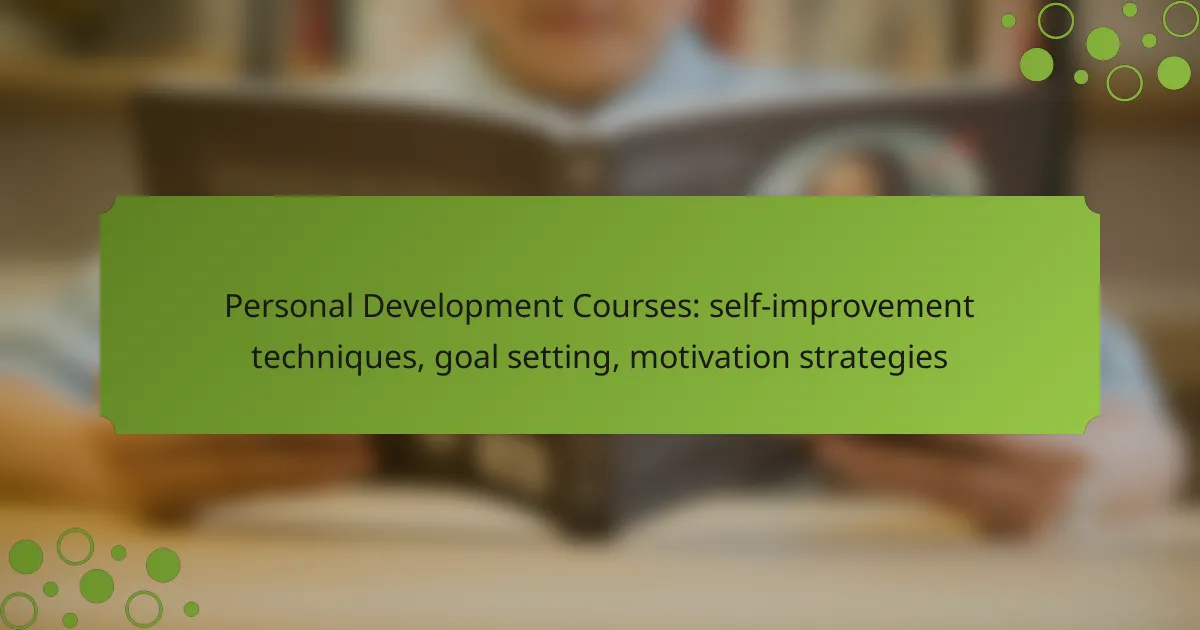
Personal development courses are designed to equip individuals with essential self-improvement techniques, effective goal-setting strategies, and powerful motivation methods. By offering structured learning and practical tools, these courses empower participants to enhance their skills and achieve meaningful personal growth. Engaging in such programs can lead to a deeper understanding of one’s aspirations and the drive to realize them.

What are the best personal development courses for self-improvement?
The best personal development courses for self-improvement focus on enhancing skills, setting achievable goals, and boosting motivation. These courses often provide structured learning paths and practical techniques that can lead to meaningful personal growth.
Mindvalley courses
Mindvalley offers a variety of personal development courses that emphasize holistic growth and self-improvement. Courses cover topics like mindfulness, productivity, and emotional intelligence, often led by renowned experts in their fields.
Participants can choose from a range of formats, including video lessons, community discussions, and interactive exercises. Mindvalley’s approach encourages a blend of personal reflection and actionable strategies, making it suitable for various learning styles.
Coursera self-improvement programs
Coursera provides access to self-improvement programs from top universities and organizations. These courses typically cover essential skills such as time management, effective communication, and leadership.
Many programs are flexible, allowing learners to progress at their own pace. Some courses even offer certificates upon completion, which can enhance your resume and demonstrate your commitment to personal growth.
Udemy goal setting workshops
Udemy features numerous workshops focused on goal setting, helping individuals clarify their objectives and create actionable plans. These workshops often include practical exercises and templates to facilitate the goal-setting process.
With a wide range of options available, learners can select courses that fit their specific needs and preferences. Prices vary, making it accessible for most budgets, and many courses come with lifetime access, allowing for ongoing reference and learning.

How can personal development courses improve motivation?
Personal development courses can significantly enhance motivation by providing individuals with the tools and techniques needed to set and achieve their goals. These courses often focus on self-improvement strategies that foster a deeper understanding of personal aspirations and the drive to pursue them.
Increased self-awareness
Increased self-awareness is a key benefit of personal development courses, as they encourage individuals to reflect on their strengths, weaknesses, values, and beliefs. This heightened awareness allows participants to recognize what truly motivates them, leading to more authentic goal setting.
To cultivate self-awareness, consider engaging in exercises such as journaling or mindfulness practices. These activities can help clarify your thoughts and feelings, making it easier to identify what drives your motivation.
Enhanced goal clarity
Enhanced goal clarity is another advantage of personal development courses, which guide individuals in defining specific, measurable, achievable, relevant, and time-bound (SMART) goals. Clear goals provide a roadmap for motivation, making it easier to track progress and stay committed.
When setting goals, break them down into smaller, manageable tasks. This approach not only makes the process less overwhelming but also allows for regular achievements that can boost motivation. Regularly review and adjust your goals to ensure they remain aligned with your evolving aspirations.

What techniques are taught in personal development courses?
Personal development courses typically teach a variety of self-improvement techniques aimed at enhancing individual effectiveness and motivation. Key methods include goal setting frameworks, visualization practices, and time management strategies that help participants achieve their personal and professional objectives.
SMART goal setting
SMART goal setting is a widely used framework that ensures goals are Specific, Measurable, Achievable, Relevant, and Time-bound. This method helps individuals clarify their objectives and create actionable plans, making it easier to track progress and stay motivated.
For example, instead of saying “I want to get fit,” a SMART goal would be “I will exercise for 30 minutes, five times a week for the next three months.” This specificity provides clear direction and measurable outcomes.
When setting SMART goals, avoid vague language and ensure that each element of the acronym is addressed. Common pitfalls include setting unrealistic expectations or failing to establish a timeline.
Visualization techniques
Visualization techniques involve creating mental images of desired outcomes to enhance motivation and focus. By picturing success, individuals can reinforce their commitment to goals and increase the likelihood of achieving them.
A simple method is to spend a few minutes each day visualizing the completion of a goal, such as giving a successful presentation or achieving a fitness milestone. This practice can help reduce anxiety and build confidence.
To maximize effectiveness, ensure that visualizations are vivid and detailed. Avoid negative imagery, as it can undermine confidence and motivation. Consistency in practice is key to seeing benefits.
Time management strategies
Time management strategies help individuals prioritize tasks and allocate their time effectively to achieve goals. Techniques such as the Eisenhower Matrix or the Pomodoro Technique can enhance productivity and reduce procrastination.
The Eisenhower Matrix categorizes tasks into four quadrants based on urgency and importance, helping users decide what to focus on first. The Pomodoro Technique involves working in focused bursts of around 25 minutes followed by short breaks, which can improve concentration and efficiency.
To implement these strategies, start by listing tasks and categorizing them accordingly. Avoid multitasking, as it can lead to decreased productivity. Regularly review and adjust your time management practices to ensure they align with your evolving goals.

What are the key components of effective goal setting?
Effective goal setting involves clarity, structure, and a focus on outcomes. Key components include defining specific objectives, establishing measurable criteria, and ensuring goals are realistic and time-bound.
Specificity of goals
Specificity in goal setting means clearly defining what you want to achieve. Instead of saying “I want to get fit,” a specific goal would be “I want to run a 5K in under 30 minutes by the end of three months.” This clarity helps in creating a focused action plan.
When setting specific goals, consider the who, what, where, when, and why. A well-defined goal eliminates ambiguity and provides a clear target to aim for, which can enhance motivation and commitment.
Measurable outcomes
Measurable outcomes allow you to track progress and determine success. This means establishing criteria that can quantify your achievements, such as tracking the number of workouts completed each week or the weight lost over a month.
To create measurable goals, use metrics that are easy to monitor. For example, if your goal is to improve sales, you might set a target of increasing sales by 15% over the next quarter. Regularly reviewing these metrics helps maintain focus and adjust strategies as needed.

How do personal development courses address common challenges?
Personal development courses tackle common challenges by providing structured techniques and strategies for self-improvement. These courses often focus on practical skills like goal setting, motivation, and resilience, helping individuals overcome obstacles and enhance their personal and professional lives.
Overcoming procrastination
Procrastination is a widespread issue that personal development courses address through various techniques. These may include time management strategies, such as the Pomodoro Technique, which encourages focused work sessions followed by short breaks. Setting clear, achievable goals can also help reduce the tendency to delay tasks.
Participants are often encouraged to identify their procrastination triggers and develop actionable plans to counter them. For instance, breaking larger tasks into smaller, manageable steps can make them feel less daunting, promoting a sense of accomplishment as each step is completed.
Building resilience
Building resilience is crucial for navigating life’s challenges, and personal development courses often teach strategies to enhance this skill. Techniques may include mindfulness practices, which help individuals stay grounded during stressful situations, and cognitive reframing, which encourages a positive outlook on setbacks.
Courses might also emphasize the importance of a support network, encouraging participants to connect with others who can provide encouragement and perspective. Regularly reflecting on personal experiences and learning from them can further strengthen resilience, allowing individuals to bounce back more effectively from difficulties.

What prerequisites should I consider before enrolling?
Before enrolling in personal development courses, consider your current skills, learning preferences, and specific goals. Understanding these factors will help you choose the right course that aligns with your self-improvement journey.
Self-assessment of current skills
Begin by evaluating your existing skills and knowledge related to personal development. This self-assessment will help you identify areas where you excel and those that require improvement, guiding your course selection.
Consider using a simple checklist to assess your skills. For example, rate your abilities in areas such as time management, communication, and emotional intelligence on a scale from 1 to 5. This can provide a clearer picture of where you stand.
Additionally, reflect on your past experiences and feedback from others. Understanding your strengths and weaknesses will not only inform your course choices but also enhance your motivation to learn and grow.


